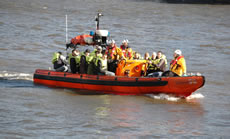Lifeboat rescues 'survivors' from stricken passenger vessel
|
On Wednesday morning 1st November Chiswick Lifeboat was a key participant in an exercise to test the effectiveness of the Thames search and rescue services in a major river incident.
‘Passenger craft Salamander was the craft that was ‘sinking’. The London Coastguard coordinated the exercise and requested assistance from the RNLI lifeboats at Chiswick and Waterloo as well as the London Fire Service boats, the Police and the PLA patrol vessels.
There were 100 passengers on board the stricken vessel and 25 were in the water. The casualties were all volunteers and those in the water were dummies. The Coastguard tasked the rescue boats coming up-river to search for the ‘bodies’ which were drifting downstream on the ebb tide. Chiswick RNLI lifeboat started the evacuation of the Salamander.
Within a few minutes of arrival on scene the first 15 ‘survivors’ were on the lifeboat on their way back to Chelsea Harbour pier. Chiswick lifeboat evacuated a further 15 people and was then tasked to join the search downstream while the police fire and PLA vessels continued with the evacuation. An RAF helicopter also took part and winched dummies from the deck of the Salamander. First aid was administered as the casualties were taken to the shore and passed into the care of the London Ambulance Service who had established a major incident centre to triage the ‘survivors’. Hammersmith and Fulham Council had set up a reception centre.
Wayne Bellamy, manager of Chiswick RNLI Lifeboat Station was involved in the de-briefing. At its conclusion he said “We were pleased with the response from the various services and the rapid evacuation of all the people on the Salamander. This was the first major exercise since the RNLI Lifeboats and the Coastguard service started on the Thames five years ago. The exercise proved its worth by demonstrating the effectiveness of the emergency services and revealing some things that would be done differently next time”.
The exercise was designed to test LESLP (London Emergency Services Liaison Panel) procedures as applied to a major incident on the River Thames. The panel ensures a partnership approach between all the relevant agencies in the planning for, and the response to, a major incident of whatever kind. The LESLP requires a major exercise to be undertaken every five years. On the RNLI lifeboats searches, recovery and first aid are practised in formal training and on each shift but only by simulating an incident as realistically as possible can the coordination between all the emergency services be evaluated.
The RNLI has 233 lifeboat stations including four on the Thames. Chiswick RNLI lifeboat became operational on the 2nd January 2002. Since then it has responded to 903 emergency calls. The four Thames lifeboats together have responded to over 3000 calls. The RNLI is entirely supported by voluntary contributions.
November 2, 2006
